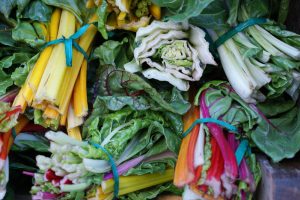White Supremacy at the Farmers’ Market

Political polarization has been increasing since the election of President Donald Trump, whose xenophobic views have emboldened white supremacists. On college campuses, violent attacks from both the left and the right amidst free speech debates have made headlines. While civic spaces like small-town libraries and farmers’ markets were thought to be free of such polarized encounters, they are no longer.
Last September, people wearing purple t-shirts reading “Justice is What Love Looks Like in Public” and “Boycott Schooner Creek Farm” protested in front of the Schooner Creek Farm booth at the Bloomington Farmers’ Market in southern Indiana. Behind the display, a young woman spoke with a customer buying potatoes and tried to ignore the protesters. The demonstration followed a summer of protests at the market, including activists giving out “Don’t Buy Veggies From Nazis” buttons and anti-fascist groups marching to the market dressed in black and covering their faces.
Since 2017, rumors had circulated that Schooner Creek farmer Sarah Dye was a white supremacist. Her racist online postings and emails were circulated within Bloomington and local anti-fascist activists began protesting against the farm. Dye posted in the online forum “Volkmom,” a “nod to the back-to-the-land völkisch [folk] movement identified with the Nazis during WWII,” according to Georgetown University’s Free Speech Project. Her comments included the following: “Any Whites who have spent time living in a neighborhood or attending a school with a non-white majority know the strife that Whites endure.”
Dye never brought her beliefs to the market in any explicit way, and yet for both sides of the conflict, she and her produce came to embody those beliefs. Dye challenged many Bloomington citizens’ image of their market. Everything she appeared to be was a lie: the wholesome image that had drawn them to buy Schooner Creek Farm’s organic products obscured the racism in their midst.
Yet left and right share much, beginning with discourses of purity and safety. Both claim to want to make the space “safe” either by closing the market to farmers who made people of color feel unsafe or by protecting the farmers and insuring their safety. Moreover, Dye’s homesteading lifestyle mirrors that of many leftist back-to-the-landers. She promotes wholesome organic food, homeschools her children, and works with herbs, weaving, and gardening. She practices contemporary Pagan rites to honor the cycle of the seasons. The land, its plants and creatures, are sacred to her. The Schooner Creek Farm website features idyllic farm scenes and states: “We seek to live in harmony with the Earth, growing healthy food and bringing light and beauty into the world. We never use synthetic chemicals or fertilizers on our crops or our land. We strive toward responsible land stewardship and community building….We just grow food.”
But for protesters, Dye’s participation in racist online forums was more than “just growing food.” The food she grows embodies the racial purity she yearns for. In interviews, Dye expresses pride in her European heritage: “my people, my folk, my blood, my ancestors.” She belongs to the American Identity Movement, formerly known as Identity Evropa which is interested in “raising white racial consciousness” and labeled as an extremist hate group by the Southern Poverty Law Center. Though a former friend of Dye’s said her Pagan rituals had no connection to racist practices, Dye came to link them and living off the land with certain forms of Norse religion that have been connected by some practitioners to racist ideologies. (Of course, many Pagans who practice Norse traditions—variously known as Heathenry, Odinism, Asatru, and others—are not racist. Groups such as The Troth and Heathens Against Hate are inclusive, welcome diversity, and argue against notions of racial purity.)
Bloomington is a liberal college town of 85,000 in the middle of a conservative swathe of rural southern Indiana. In the 1920s, Indiana was home to one of the most powerful branches of the Ku Klux Klan, and Klan activity has not entirely disappeared from the state. White racist groups came to Dye’s defense, supporting her right to free speech. According to a story in the New York Times, “armed members of a conservative militia group drove into Bloomington to support the farm against what they called anti-fascist enemies.” As one observer told me, Dye has become a “martyr for the cause of white supremacy.” In a September meeting at a public library in Ellettsville, a small town outside Bloomington, an organization called “Grassroots Conservatives” invited Dye to tell her story at their meeting. Protesters showed up, and some painted blood on her car.
By the beginning of 2020, the city had not found a way forward out of the conflict. Some pushed for the market to privatize, but the majority of farmers signed a petition to keep the market in the city’s hands. Perhaps the common ground both sides share might be a place to begin. How did Dye, a self-professed former liberal and feminist come to hold such views? There is no way to find out without engaging her in conversation rather than shouting matches. Ostracizing her from the market and from dialogue sends her back to hate-filled Internet sites. Farmers’ markets and public libraries have the potential to be a meeting ground for a wide range of citizens’ perspectives, where protests and dialogue might coexist.
#
Sarah M. Pike, Ph.D., is Professor of Comparative Religion and Chair of the Department of Comparative Religion and Humanities at California State University, Chico. She has written numerous articles and book chapters on contemporary Paganism, ritual, the New Age movement, the primitive skills movement, the Burning Man festival, spiritual dance, memorializing; environmental activism, and youth culture. Her most recent book is For the Wild: Ritual and Commitment in Radical Eco-Activism (University of California Press, 2017), an ethnographic study of radical environmental and animal rights activism, ritual, and youth culture.
Counterpoint blogs may be reprinted with the following acknowledgement: “This article was published by Counterpoint Navigating Knowledge on 22 January 2020.”
The views and opinions expressed on this website, in its publications, and in comments made in response to the site and publications are those of the author(s) and do not necessarily reflect the views and opinions of Counterpoint: Navigating Knowledge, its founders, its staff, or any agent or institution affiliated with it, nor those of the institution(s) with which the author is affiliated. Counterpoint exists to promote vigorous debate within and across knowledge systems and therefore publishes a wide variety of views and opinions in the interests of open conversation and dialogue.



